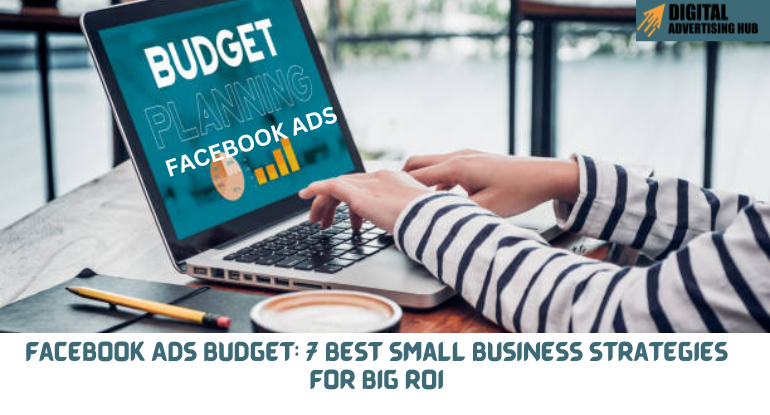“What is a reasonable Facebook ad budget to start with?” I’ve been asked this question a number of times, and to be honest, the response differs depending on the business. Several calculated procedures must be taken when creating an efficient Facebook ads budget in order to maximize your advertising spending and return on investment (ROI).
Starting small with a $5 to $10 daily budget is a great idea if you’re new to Facebook advertising and want to see results as you acquire experience. In other words, start small and grow.
With the help of this in-depth blog article, you will have the information and tactics necessary to maximize the return on your Facebook Ads investment and guarantee that your business has a notable increase in sales, brand recognition, or consumer engagement.
What is Facebook Ads Budget?
Small companies may benefit greatly from Facebook Ads, but understanding the world of advertising expenses can be challenging. In order to help you make the best choices and maximize the return on your marketing expenditure, this section will simplify the idea of Facebook Ads budgets.
Consider it a Targeted Investment: Facebook Ads provide you the ability to precisely target your ideal consumer, in contrast to more conventional marketing techniques. Suppose you are at a trade fair and, rather than a generic booth, you have a personalized one that draws only those prospective clients who are truly interested in your offering.
Your Budget is the Fuel: This customized strategy is powered by your Facebook Ads budget. It’s the entire amount you are willing to spend on your campaign, much like the money you would set aside for printing marketing materials or going to a trade fair.
What Budgeting Options Are Available for Facebook Ads?
A customizable budgeting mechanism is provided by Facebook Ads to support a range of campaign objectives and financial constraints. Below is a summary of the main choices:
#1. Daily Budget: Using this option, you may decide how much you’re prepared to spend every day on your advertising campaign. This guarantees continuous expenditure and works well for campaigns that need to serve ads consistently throughout the day.
#2. Lifetime Budget: This is where you decide how much money you’re ready to spend overall during the run of your campaign. This is a wise choice for initiatives that have set budgets and timelines. In order to maximize delivery, Facebook will automatically allocate your spending throughout the campaign.
Additional Budgeting Choices:
#1. Campaign Budget Optimization (CBO): This choice enables Facebook to allocate your money across the various ad sets in your campaign automatically. Depending on the aim of your campaign, the objective is to maximize outcomes and optimize delivery.
#2. Manual Bidding: This method gives you greater control over the price of your advertisements. For clicks (CPC), impressions (CPM), or other activities, you can establish distinct bids. A better comprehension of Facebook Ads and the advertising auction mechanism is necessary for this strategy.
Selecting the Appropriate Budgeting Choice:
The ideal budgeting choice is determined by your campaign’s objectives and comfort level with money:
1. For first-time users with a daily spending cap: To guarantee regulated spending, start with a daily budget.
2. For campaigns with set budgets and timelines, use lifetime budgets for predictable expenses.
3. If you’re an expert user looking for the best possible delivery, check out Campaign Budget Optimization.
4. For experienced users who require fine-grained control: Take into account manual bidding.
Recall that Facebook Ads Manager offers resources and tools to assist you in estimating possible prices and reach depending on your bidding and targeting tactics.
What Factors Affect Facebook Ads Budget?
The following variables may affect how much your Facebook Ads campaign costs:
#1. Targeting: Because there is a smaller audience pool, the more detailed your targeting criteria (age, geography, and interests), the higher the possible cost per click (CPC) or impression (CPM).
#2. Bidding technique: Your budget is directly impacted by the bidding technique you select (CPC, CPM, etc.). Higher CPC or CPM bids will typically result in speedier ad delivery, but they may also quickly exhaust your budget.
#3. Competition: The degree of rivalry among your target market may have an impact on expenses. You might have to submit a larger bid to secure ad slots if other marketers are fighting for the same audience.
#4. Ad Creatives: Since Facebook awards advertisements that result in good user interaction (clicks, shares, etc.), ads with compelling, high-quality images and language can potentially save expenses.
When Should I Increase My Facebook Ads Budget?

The following signs suggest that it may be time to raise your Facebook Ads budget:
#1. The campaign is operating effectively: Are you surpassing your targets for conversion rates or click-through rates (CTR)? Is there a profit being made from your marketing in terms of ROI? If so, raising your spending will enable you to succeed by reaching a larger audience.
#2. You regularly spend your budget: Your daily or lifetime Facebook ads budget may need to be increased in order to take advantage of the momentum if it is continuously depleted during the campaign.
#3. You’ve found possibilities for optimization: When you examine your campaign statistics, you may find areas that may use better, including broadening the target demographic or experimenting with different ad versions. Increasing your Facebook ads budget will enable you to investigate these optimization techniques.
Recall that raising your budget ought to be a calculated choice determined by performance and facts. For testing, start small and work your way up to a larger budget as you acquire experience and maximize the return on investment from your campaigns.
You can efficiently manage your Facebook Ads budget and make sure your small business gets the most out of its advertising investment by being aware of these budgeting choices, considerations, and best practices.
How Can Facebook Ads Help My Small Business?
There are a lot of hats to wear while running a small business, and marketing is sometimes neglected. Facebook Ads may be your hidden asset, assisting you in achieving a number of objectives and growing your company. Facebook Ads should be a part of your small company strategy for the following 7 strong reasons:
#1. Make Contact with Your Ideal Client: Dispersed marketing strategies should be abandoned. With Facebook Ads, you can precisely target the person you want as a customer. Ads may be customized to target the precise individuals most likely to be interested in what you have to offer based on demographics, hobbies, or online behavior.
#2. Increase Brand recognition: In the congested market of today, brand recognition is essential. With Facebook Ads, you can reach a larger audience—even if they aren’t actively looking for your product or service yet—by promoting your brand. As a result, you establish yourself as a leader in your field and increase brand awareness.
#3. Increase Website Traffic: Facebook Advertising persuade people to visit your website, look at your products, and even become paying clients by creating engaging advertisements.
#4. Create Leads and Sales: Facebook Ads may be an effective strategy for generating leads in addition to increasing company recognition. Employ targeted advertising to gather the contact details of prospective clients who could be interested in your services. This enables you to develop leads via email marketing or other methods, which eventually increases revenue.
#5. Publicize Special Offers and Events: Are you hosting a local event, a flash sale, or the debut of a new product? Facebook Ads is the ideal medium for word-of-mouth marketing. Ads that are specifically targeted to your audience may create excitement and make sure they don’t pass up these unique possibilities.
#6. Develop Community and Relationships: The main goal of social media is to connect people. With Facebook Ads, you can build relationships with your target audience by interacting with them through interactive campaigns, comments, and content engagement. This promotes repeat business and strengthens brand loyalty.
#7. Measurable Outcomes: Facebook Ads provide unmatched data and analytics in contrast to conventional marketing techniques. You are able to monitor the effectiveness of your efforts in real time, determine what is and is not working, and modify your approach to get the best possible outcomes.
By doing this, you can guarantee that your marketing money is used wisely and optimize your return on investment (ROI). Facebook Ads are an effective tool that may help small businesses reach their marketing objectives since they provide a focused and quantifiable approach.
How Can I Plan a Budget-Friendly Facebook Ad Campaign?

Having considered the benefits of Facebook advertising, it is a go-to tool for expanding your small business. Now that we’re in the planning phase, we can make sure that your campaign succeeds even on a tight budget.
The essential stages to get you going are as follows:
#1. Establish SMART objectives:
Setting quantifiable and precise goals for your campaign is essential before you start creating ads. The word SMART stands for Specific, Measurable, Achievable, Relevant, and Time-bound. Keep that in mind.
1. Specific: What particular results are you hoping to attain from your ads? Is it drawing more customers to your local business via foot traffic, increasing website traffic, or online course signups?
2. Measurable: How are you going to monitor your development? Choose metrics (website clicks, conversions, etc.) that are directly related to your objectives from the abundance of data that Facebook Ads Manager offers.
3. Achievable: Set reasonable expectations for yourself, particularly in the beginning. Setting attainable goals and progressively increasing them as your campaigns are optimized is preferable.
4. Relevant: Harmonize your objectives with your overarching company plan. For example, website clicks may be a more important indicator than immediate purchases if your main goal is to increase brand recognition.
5.Time-bound: Give your campaign a deadline. This will enable you to allocate your budget and properly examine the outcomes.
#2. Understanding Facebook Ads Costs:
Although Facebook Ads provide an effective way to connect with your target audience, understanding the world of advertising expenses may be challenging. To assist you in making wise choices and making the most of your money, consider the following breakdown:
The System of Bidding:
Facebook Ads uses an auction model of operation. Envision several marketers competing for the same ad space, whether it be in the sidebar, newsfeed, or other areas where people view your advertisements.
You must place a bid in order to be the winner of this competition and have your ad displayed. The greatest amount you are prepared to spend for a certain activity, such a click or impression, is represented by this bid.
Fortunately, Facebook provides a variety of bidding techniques to fit your objectives and financial constraints.
#1. Cost-per-click (CPC): Increasing traffic to your website or landing page is a common goal with this strategy. You may choose the maximum amount you are ready to spend using CPC bidding for each time a user clicks on your advertisement.
For instance, even if someone places a higher offer, if you set a CPC bid of $0.50, you will never pay more for each click. With this option, you can manage your spending more effectively and make sure that you only pay when a customer clicks through and expresses real interest in what you’re selling.
#2. Cost-per-thousand-impressions (CPM): With this strategy, reaching a large audience is given first priority. When using CPM bidding, you choose the maximum price you’re ready to pay for each 1,000 impressions (displayed times) of your advertisement. If increasing brand recognition and putting your product or service in front of more people is your main objective—even if they don’t necessarily click through right away—this might be a smart tactic.
Choosing the Right Bidding Strategy:
Your campaign’s objectives will determine the best course of action:
1. Pay attention to lead generation or website traffic? Your best option could be CPC bidding because you only have to pay when a user clicks to indicate their interest.
2. Giving brand awareness first priority? With CPM bidding, you may reach more people for a fixed price.
Creating Facebook Ads Budget:
The best thing about Facebook Ads is that you are in total control of how much you spend. You have the option of setting a total campaign budget, which is the utmost amount you are prepared to spend for the course of the campaign, or a daily budget, which specifies how much you are willing to spend each day.
You don’t have to start with a huge expenditure! If your targeting is accurate and your advertising are strong, even a little daily expenditure may provide noticeable benefits.
Additionally, Facebook Ads Manager provides useful tools to optimize your bids and make sure you’re getting the most out of your investment. Start with a lower bid and gradually increase it as your campaign performance improves and you feel more confident in your targeting approach.
Try out several bidding techniques and monitor your outcomes to see which ones are most effective for your campaign.
Even as a small company owner, you can make sure your budget is used wisely and maximize your return on investment by being aware of the expenses associated with Facebook Ads and selecting the best bidding strategy for your objectives.
3. Prioritizing Targeting:
Reaching the proper audience with your adverts is where the magic happens. Based on demographics (such as age and region), hobbies, and activities, Facebook provides robust targeting capabilities.
The secret is to narrow your emphasis to your target client. For instance, you wouldn’t want to market to individuals without dietary constraints if you owned a bakery that specializes in gluten-free goods. Instead, target those with celiac illness, health food lovers, and those interested in gluten-free choices.
Even with a limited budget, you can maximize your return on investment by giving smart targeting first priority and making sure your message reaches the most responsive demographic.
How Can I Create High-Impact Facebook Ads on a Budget Without Breaking the Bank?
Now that you’ve determined your objectives, allotted funds, and refined your targeting approach, the foundation for a fruitful Facebook Ad campaign is in place.
The important part now is to create eye-catching advertisements that appeal to your target audience and capture their attention. The favorable tidings? To make powerful Facebook ads, you don’t need a Hollywood budget or an expert design team.
Here are some essential tactics to get the most of your influence even on a low budget:
#1. Compelling Copywriting
Your advertisement’s words are your persuading prod that gets people to act. Here’s how to write copy that works:
1. Be succinct and clear: People are inundated with information on the internet. Concentrate on a single, impactful statement that draws attention right away.
2. Emphasize the advantages: Go beyond simply describing your good or service to show how it will help your intended market. Pay attention to what important to them: reaching a goal, fixing an issue, or making improvements in their life.
3. Make forceful requests for action: Give the audience clear instructions on what you want them to do: visit your website, register for a free trial, or find out more. Make your Call to Action (CTA) clear.
#2. Visual Appeal:
To capture attention and halt the scroll, high-quality images are crucial. Here are some ways for saving money:
1. Free Stock photographs: Royalty-free stock photographs are available on many websites and may be a great resource. Select visuals that complement your message and have a pleasing appearance.
2. Canva: This free web design service provides easy-to-use tools for making visually appealing images and videos for your advertisements. No prior design knowledge is required!
3. User-Generated Content (UGC): Use actual consumer images and testimonials to highlight the benefits of your product or service. UGC has the power to persuade people and foster confidence in the eyes of potential clients.
#3. A/B Testing:
Facebook Ads are beautiful since they can improve your campaign to get better results. You may compare many iterations of your advertisement (copy, images, etc.) using A/B testing to see which ones work best.
This is how it operates: Make many versions of your advertisement and allow Facebook to display them to various groups of people. The application will monitor the outcomes and notify you of the version that receives the most clicks, conversions, or interaction.
You may maximize your return on investment (ROI) with each impression and click by employing A/B testing to continually improve your advertising and make sure they’re connecting with your target demographic.
Maximizing ROI with Budget-Smart Strategies
Optimizing your return on investment even with a well-designed ad campaign necessitates regular tuning and thoughtful application of Facebook’s advertising capabilities. Here’s how to make the most of your spending and guarantee that your Facebook ads produce noteworthy outcomes for your local business:
#1. Take use of Facebook Pixel
Consider the Facebook Pixel your covert tool for monitoring conversions and gauging the success of your campaigns. Facebook can track what occurs when a user clicks on your advertisement thanks to this little bit of code that you post on your website. Have they gone to a particular product page? Join your email list, please? Make a purchase? The Pixel offers useful information about these important tasks.
You can maximize the effect of your adverts by knowing what consumers do after clicking on them. You may narrow down your ad wording to better resonate with the audience doing particular behaviors, target people who are more likely to convert, and ultimately get more value out of each dollar you spend on advertising.
#2. Retargeting and Lookalike Audiences: Facebook Ads are effective means of connecting with people who have already engaged with your business.
1. Retargeting: Do you have website users that looked through your items but didn’t buy anything? With retargeting, you can show these people personalized advertisements to remind them of your products and encourage them to come back and finish the transaction. This is a really powerful tactic to increase your ROI and conversion rate.
2. Lookalike Audiences: Use Lookalike Audiences to further refine your targeting. Facebook leverages its extensive user base to find new users who are similar to your current clients or site visitors.
By doing this, you may increase the likelihood that a highly relevant audience will be interested in your product or service, increasing the likelihood that conversions will occur and your return on investment will rise.
#3. Engagement & Community Building: Increasing instant conversions isn’t the only goal of Facebook Ads. It also involves developing a devoted community, cultivating relationships with your target audience, and raising brand recognition.
Promote engagement with your advertisements by posing queries, holding competitions, or providing insightful material. Facebook’s algorithm will favor your advertising more the more people interact with them, which will naturally increase their reach and brand exposure. Your advertising efforts will provide a higher return on investment thanks to this organic reach.
By putting these clever budget-friendly tactics into practice, you can make sure that your Facebook Ads campaign turns your target demographic into devoted clients and significantly increases sales for your small business.
How Can I Track My Results and Optimizing for Success?

Facebook Ads are beautiful because of their strong data analytics in addition to their targeting options. To optimize your return on investment and continually improve your campaign for better outcomes, it is essential to understand how your advertisements are doing. Here’s how to use Facebook Ads Manager to monitor your development and make successful optimizations:
#1. Being familiar with Facebook Ads Manager
Your main tool for planning, organizing, and evaluating your advertising campaigns is Facebook Ads Manager. It offers an abundance of information on important parameters like:
- Impressions: The quantity of times your advertisement was shown.
The number of individuals that clicked on your advertisement. - Conversions: How many people clicked on your advertisement and completed the required action (visiting your website, making a purchase, etc.).
- Cost per Thousand Impressions (CPM) or Cost per Click (CPC): These let you assess how cost-effective your campaign is.
#2. Data-Informed Choices:
Avoid becoming overwhelmed by the facts! Pay attention to the indicators that matter most to your marketing objectives. For instance, give clicks and website visits top priority if increasing website traffic is your main goal. The percentage of clicks that result in real purchases or signups is shown by conversion rates.
This data analysis can help you pinpoint areas that need work. Does your audience connect with the copy in your ads? Are you aiming for the appropriate demographic? Are your pictures strong enough? Make use of these information to improve the targeting approach, hone the text of your ads, and allocate funding more efficiently among several ad groups.
#3. Continuous Improvement:
The environment for digital advertising is always changing. Success is mostly dependent on ongoing testing and optimization. Try out several ad forms, play around with different text and graphic styles, and keep a watch on new trends.
Facebook Ads Manager makes it simple to test several versions and modify settings, ensuring that your campaign continues to be relevant and successful over time.
Recall that maximizing return on investment from Facebook ads is a continuous effort. Through consistent data analysis, data-driven optimization, and ongoing experimentation with new strategies, you can guarantee that your Facebook Ads campaign produces outstanding outcomes for your small business, turning a tight budget into a major growth engine.
Conclusion
As a small business owner, you recognize the value of making the most of your resources. Facebook Ads provide an unrivaled chance to connect with your ideal customers, increase brand recognition, and spur substantial growth—all without breaking the budget.
You have now been equipped with the skills and information necessary to create effective Facebook Ads budget. Recall that the secret is in:
1. Astute Targeting: Focus intently on your target client to make sure the correct people will be receptive to your message.
2. Captivating Creatives: Provide attention-grabbing content and images in advertisements that persuade viewers to take action.
3. Budget Optimization: Make the most of your reach while staying inside your allotted budget by using economical bidding techniques.
4. Statistics-Driven Decisions: Monitor your campaign’s performance, examine statistics, and make adjustments as needed.
By adhering to these guidelines, Facebook Ads may be transformed from a rather intimidating platform into an effective instrument for growing your small business.
Launch your Facebook Ads campaign, harness the power of niche marketing, and see the growth of your business!




